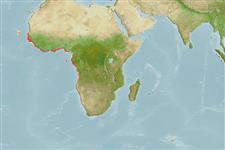Common names from other countries
Environment: milieu / climate zone / depth range / distribution range
Ecologie
; diepteverspreiding 0 - 90 m (Ref. 435), usually 4 - 40 m (Ref. 435). Tropical; 17°N - 19°S, 25°W - 14°E
Eastern Atlantic: Western African coast from Mauritania to Namibia.
Length at first maturity / Size / Gewicht / Leeftijd
Maturity: Lm ? range ? - ? cm Max length : 10.8 cm CW mannelijk/geslacht niet bekend; (Ref. 435)
Occurs at depths from shore to 90 m (Refs. 435, 2708); common at depths of 4 to 40 m. Burrows in sand or fine gravel and also in bottoms with other sediments. (Ref. 435). Can live on all level substrates but may prefer sand (Ref. 2708). In general, Calappa feeds upon molluscs and hermit crabs in gastropod shells. Their right claw is used for crushing shells of prey while their left claw is used as a cutter (Ref. 105092).
Life cycle and mating behavior
Geslachtsrijpheid | Voortplanting | Kuitschieten | Eieren | Fecundity | Larven
Members of the order Decapoda are mostly gonochoric. Mating behavior: Precopulatory courtship ritual is common (through olfactory and tactile cues); usually indirect sperm transfer.
Fischer, W., G. Bianchi and W.B. Scott (eds.). 1981. (Ref. 435)
Status op de Rode Lijst van het IUCN (Ref. 130435)
Status bij CITES (Ref. 108899)
Not Evaluated
Not Evaluated
Gevaarlijk voor mensen
Harmless
Gebruik door de mens
Visserij: commercieel
| FishSource |
Tools
Meer informatie
Leeftijd/GrootteGroeiLengte-gewicht parametersLengte-lengte parametersMorfologieLarvenAbundantie
Internet-bronnen
Estimates based on models
Preferred temperature
(Ref.
115969): 21.7 - 28, mean 26.2 (based on 116 cells).
Kwetsbaarheid
Low vulnerability (10 of 100).
Prijsklasse
Unknown.
